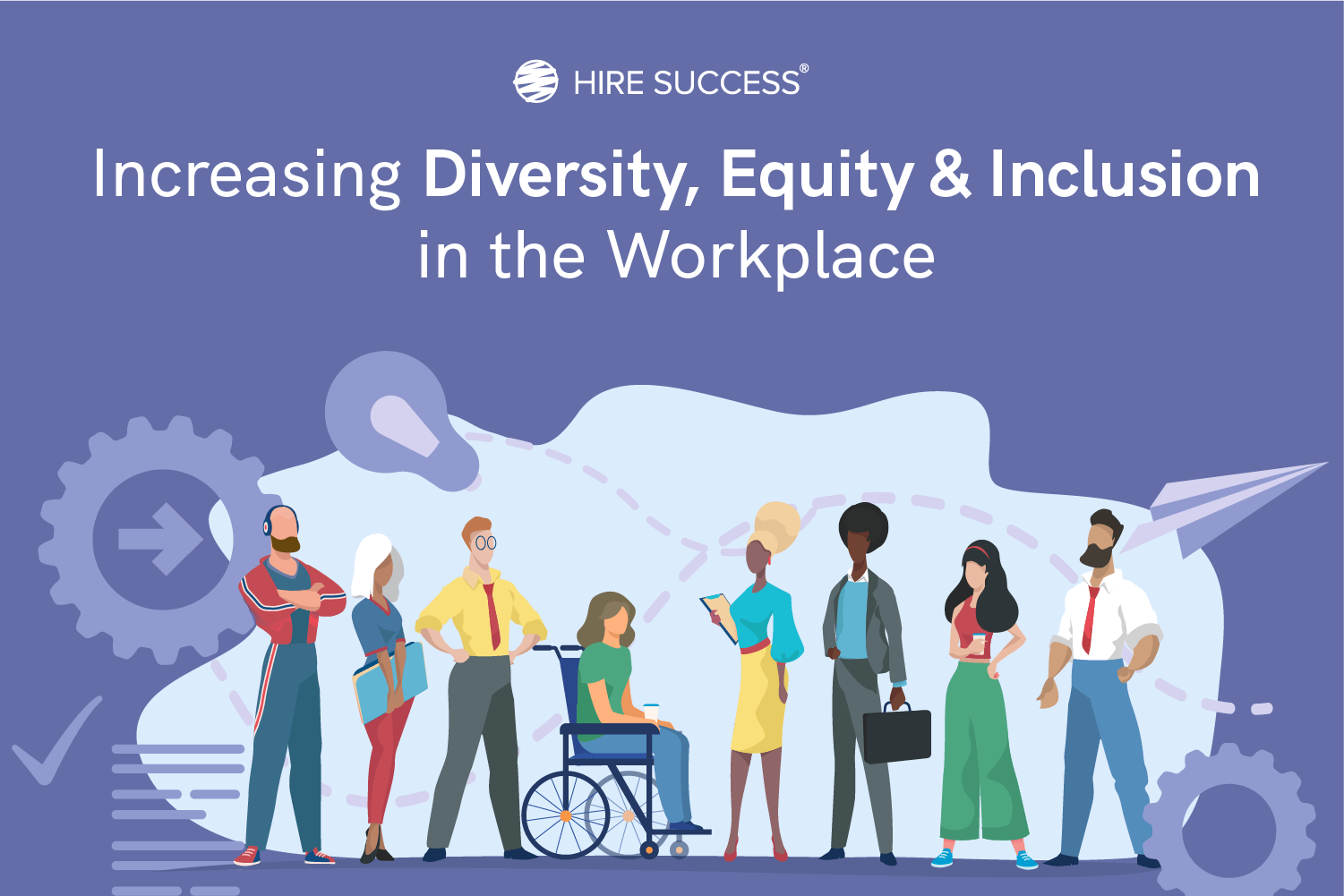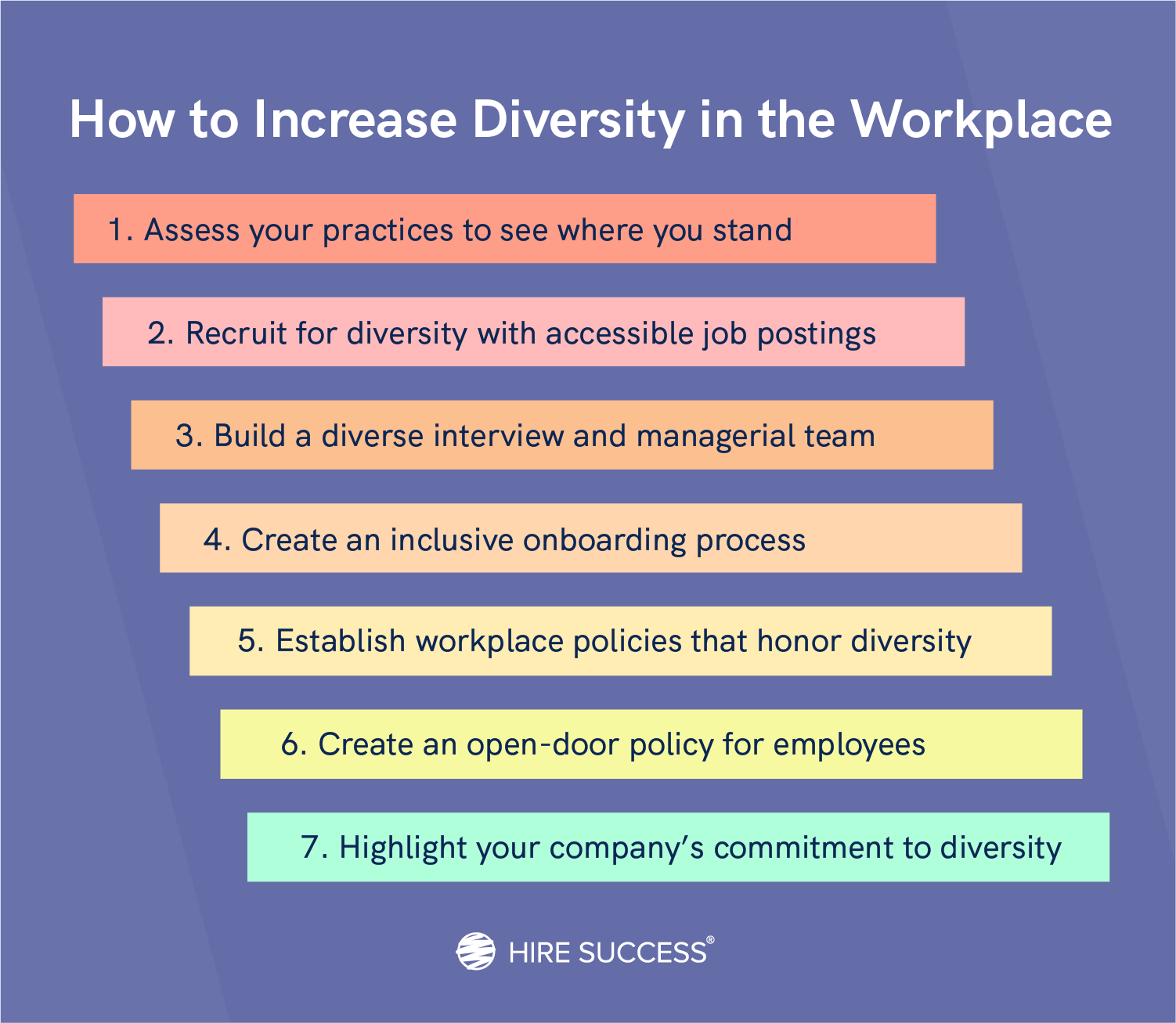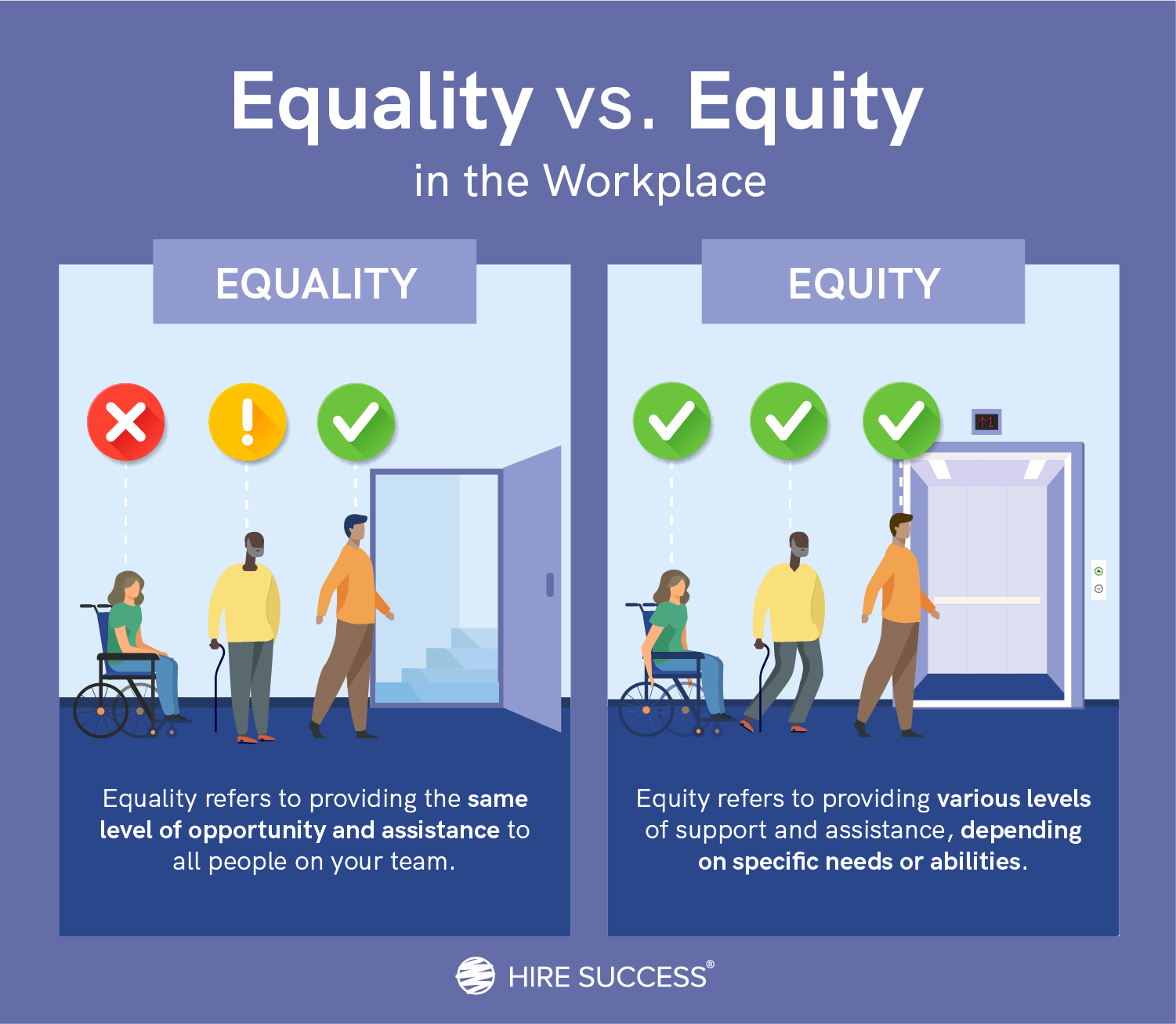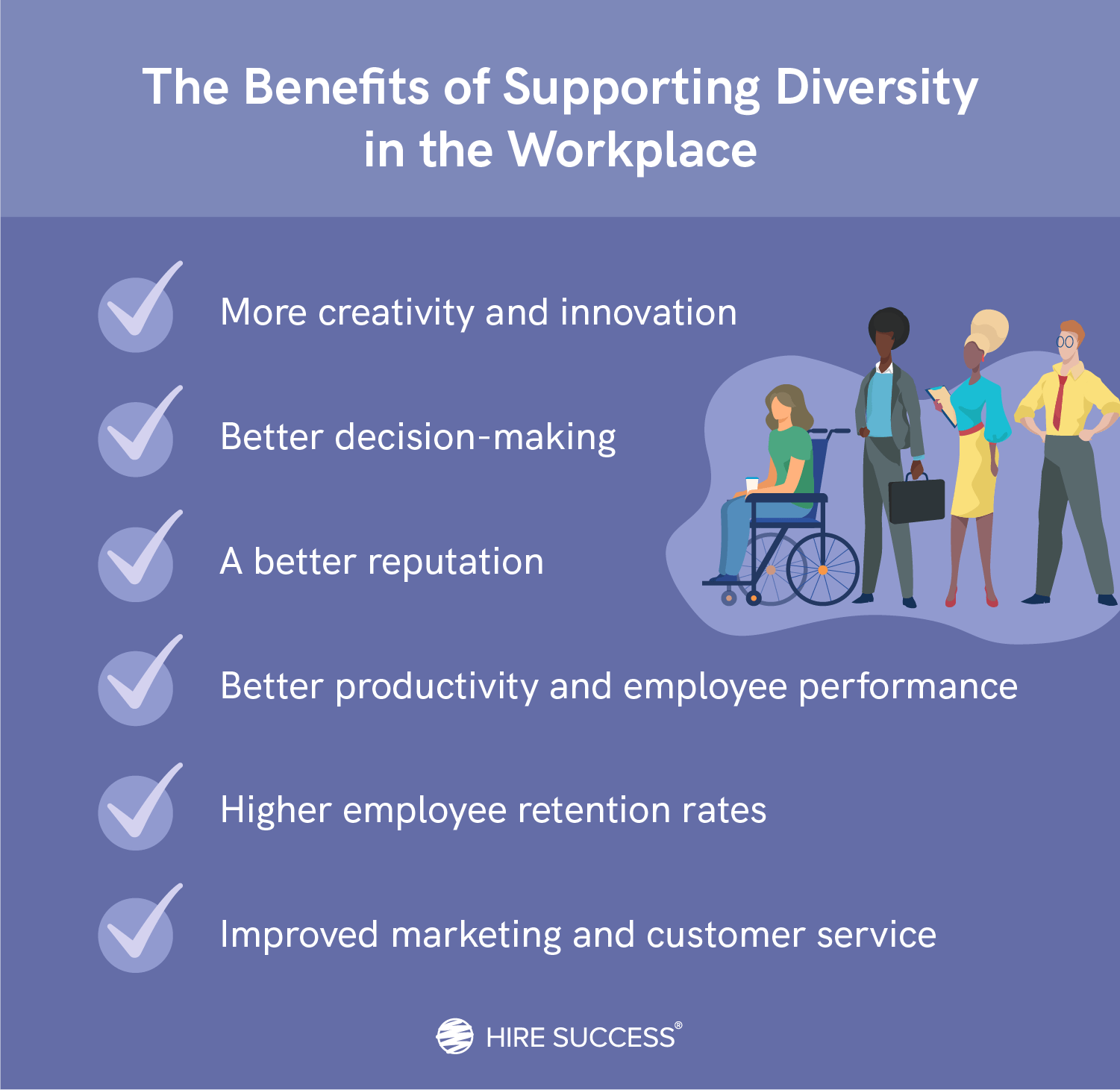Increasing Diversity, Equity & Inclusion in the Workplace

As America — and workplaces around the globe — continue to become increasingly diverse, businesses have placed more focus on workplace diversity, equity, and inclusion.
Why does this matter? People from different backgrounds, cultures, genders, and generations can have vastly different perspectives on all sorts of issues. They can bring different skills, strengths, abilities, and ideas to your company.
Making workplace diversity a priority is clearly important, but so is helping management and staff understand the role they play in creating a culture where people from all backgrounds feel included.
Today’s job force reflects a more diverse population. And data shows that diversity, equity, and inclusion matter to job applicants — and to companies’ results:
- More than 4 out of every 5 employees responding to a 2019 Yello survey agreed that diversity is so important in the workplace that an employer’s commitment to diversity would be a deciding factor in accepting a job offer.
- That same survey reveals that 70% of employees would consider leaving their job if their current employer didn’t demonstrate an adequate commitment to diversity in the workplace.
- Diverse companies enjoy 2.3 times higher cash flow per employee.
- Only 56% of the 87 million millennials in the U.S. are white as compared to 72% of the 76 million baby boomers.
In this article, we’ll explore the importance of diversity in the workplace, differences between diversity, equity, and inclusion (DEI) and examine how to implement DEI initiatives in your business. We’ll also discuss diversity and inclusion best practices, and suggest how to promote diversity and inclusion in your workplace.
Understanding Diversity, Equity, and Inclusion (DEI) Initiatives
The first step in understanding where diversity, equity, and inclusion practices in your own hiring may be lacking is to take a close look at where you currently stand. Collecting data is an important place to start. Without that data, you can’t truly identify issues and make positive changes.
For example
- How many people on your management team are women or people of color?
- Do you have people with disabilities or from different cultural, ethnic, or religious backgrounds at all levels of your organization?
Achieving workplace diversity, equity, and inclusivity starts with thoroughly assessing your company’s practices and procedures, as well as understanding things like your own personal biases (and those of your hiring team), historical trends in hiring/recruiting, your onboarding, employee retention rates, and even offboarding processes.

What is diversity in the workplace?
Diversity in the workplace refers to the mix of differences and similarities among team members in all areas of identity. Those areas of personal identity can include (but aren’t limited to):
- Race
- Gender
- Age
- Sexual orientation
- Nationality
- Language
- Religious or spiritual beliefs (or nonbelief)
- Family/marital status
- Education level
- Physical and neurological ability
- Body size or type
- Socioeconomic background
- Political ideology
- Education
- Culture
- Veteran status
- Former incarceration
Importance of diversity in the workplace
Why is diversity important in the workplace? Because people have different experiences, skills, and ways of doing things from one another. They bring different perspectives, strengths, and ways of looking at and solving problems.
What is equity in the workplace?
Equity in the workplace exists when everyone on your team has equal access to opportunity, success, and advancement. For an example of equity in the workplace, imagine you have a management position open up. In an equitable business, every qualified person on your team would have the support necessary to access the opportunity for that promotion. That could mean training programs, or it could mean an office that’s accessible by wheelchair, or it could mean a job description stripped of bias toward a particular type of person.
When you create a culture of equity, you create a workplace where employees are seen, valued, and supported. In turn, employees are more likely to do their best work and less likely to leave, because they’re happier in their work and see that their efforts will be rewarded fairly.
Equity vs. equality in the workplace

What’s the difference between equity and equality in the workplace? Equality refers to providing the same level of opportunity and assistance to all people on your team. On the other hand, equity refers to providing various levels of support and assistance, depending on specific needs or abilities. Although important, equality can have a one-size-fits-all aspect that removes or minimizes differences. Equity is about meeting people where they are, recognizing what makes them different and/or the same as others, and understanding that it’s only fair to make room for all.
To give an example of equity in the workplace and how it contrasts with equality, say you’re hiring for a new position. A workplace with equality would extend that job posting equally to people in wheelchairs as well as those who can walk. An equitable workplace also has the facilities, tools, and access a person in a wheelchair would actually need to be able to do that work.
What is inclusion in the workplace?
Inclusion in the workplace is the collective action taken by an organization to make sure all employees, regardless of identity, feel like they belong on the team and are fully respected and supported. A business with inadequate inclusion cannot fully benefit from its diversity and achieve equity.
An inclusive workplace is one that actively acknowledges and respects differences among members of its workforce. It offers learning, training, and mentoring opportunities for skill development and career growth. Inclusion in the workplace also provides for open communication between employees and management — especially if staff are feeling left out, harassed, or discriminated against in any way. And just as importantly, there should be clear nondiscrimination and anti-harassment policies in place that hold people to account for their actions while on the job.
Creating a culture of inclusion is not something that happens overnight. It requires asking employees questions, listening carefully, and thinking about ways to help staff feel that they are valued. It means recognizing that you may need to make changes in how your office is organized and how it operates.
Recruiting for diversity
Creating a more diverse, inclusive work environment begins with examining how you recruit job applicants. Ask yourself where you’re listing opportunities and what wording/language you’re using to indicate that your business encourages applicants of all backgrounds and abilities.
Recruiting a diverse workforce also starts by making job postings accessible to a wide range of candidates. You should also ensure that your recruiters, including members of your interview team, are aware of the risk of implicit bias and take specific steps to avoid making decisions that may be affected by it.
Make your job postings accessible to candidates of color
The wording you use in your job postings is important. For instance, scrutinize your writing to see whether it’s inclusive of women and candidates of color. In your post, use gender-neutral language whenever possible, and address the fact that you’re an equal-opportunity employer that doesn’t discriminate based on age, gender, race, physical or neurological ability, culture, sexuality, or religious background.
You may also want to look at posting in print (as not all people have a computer available), asking current employees to spread the word among friends or former colleagues, or posting on the following sites:
- IMB Diversity
- Professional Diversity Network
- Equal Opportunity Publications
- Hispanic/Latino Professionals Association
- Black Jobs
- NativeHire
- Female Executive Search
- We Hire Women
- AllLGBTJobs.com
- Campus Pride
- abilityJOBS
- 70 Million Jobs
- Workforce50
- Hire Heroes USA
When describing your company culture, state that you welcome and celebrate diversity in your workplace. Even better, give specific examples when describing your company culture, such as offering time off for a variety of religious holidays, providing all-gender bathrooms, or offering both maternal and paternal leave.
When outlining the required skills for the job, be honest and open. If a college degree is not required, mention it. Sometimes, having experience or the right attitude and willingness to learn is more important than a degree.
One great way to ensure that you bring in qualified candidates from all backgrounds is to rely more on objective data. You can determine the skills and personality traits that lead to success for a specific position by creating baselines, and then give pre-employment tests to all applicants who meet the basic requirements outlined in your job posting. By basing your top candidates on data, not impressions you get from a résumé, you can be more objective during the initial stages of the hiring process.
Give your recruiters tools to recognize and avoid implicit bias
You might think that your hiring process is free of bias, but chances are that’s not the case.
Every person has biases and preferences — we’re human, after all! — and we tend to like or gravitate toward people who have things in common with us. If we see on a résumé that someone went to the same school we did or has similar interests or hobbies, we’re often predisposed to like what we see and select that person for an interview.
You can limit diversity without even being conscious of it. Choices are often made subconsciously that lead to a less-diverse, less-inclusive work environment. Talking to your hiring team openly about unconscious or implicit bias is a good start. But it’s also important to look for ways to choose candidates more objectively.
For instance, you can use a system like Hire Success® to create employee baselines to outline the specific skills and personality traits that lead to success for each job. You can then use pre-employment skills testing and personality testing to narrow down your list of qualified candidates so that you base your decisions on data, not what you see on a résumé.
A system like Hire Success® also provides you with interview questions based on testing results, so you’re more likely to focus on capabilities and traits rather than first impressions.
Increasing diversity at work through your interviews
Increasing diversity at work starts with the hiring and interview process — and with the people who are part of your interview team. Having a diverse hiring panel can bring a range of perspectives to the table and help you avoid bias in your decision-making.
Build a diverse and inclusive interview panel
Do you have people on your interview panel who are from diverse backgrounds and cognitive or physical abilities? Do you have women, people of color, or multilingual members on your hiring team? When candidates see that you have a diverse interview panel, it makes a difference in their assessment of your company culture — but it also makes a difference to your existing team because you demonstrate that different opinions and backgrounds matter.
It’s also important to have your hiring team focus interview questions around skills relevant to job duties. By helping you focus on data and results from pre-employment tests, a system like Hire Success® can help ensure that your interview panel further avoids implicit bias.
Assess your managerial and executive teams
Having a group of people from various backgrounds on your management and executive teams is an example of diversity in the workplace. This not only provides for better decision-making from the top down but also shows job candidates that people from diverse backgrounds are valued, respected, and provided with opportunities to grow and succeed at your company.
Unfortunately, women and individuals of color are often less likely to be on executive teams or be represented on boards of directors in American companies. For instance, a Deloitte report found that in 2018:
- 80.7% of new directors on Fortune 500 boards were white
- 59.6% of those new directors were white men
In order to make progress, conversations are needed among management teams about how to build a more diverse, equitable, and inclusive team. Answering the following questions could be a good starting point:
- Who makes up our management team?
- Which groups of people are or are not represented?
- Are all our employee groups represented?
- Is everyone’s presence equally valued?
- Have everyone’s ideas been heard and seriously considered?
- Is this environment safe and welcoming for everyone? Is anyone’s safety being unfairly sacrificed for the comfort of others?
- What steps have we taken to make management positions more accessible to underrepresented groups?
- What systems do we have in place to broaden the support and impact of our DEI initiative?
- Do we have goals in place, such as diversity metrics, definitive policies around equity and inclusion, specific training and mentoring initiatives, etc.?
- How have we improved from this time last year? What do we need to keep working on?
It’s important to make sure your management/executive team has the skills and attitudes necessary to make your DEI initiative successful. If you feel those skills or traits are currently lacking on your management team, you can use a tool like the Hire Success® Personality Profile to objectively look for what you’re missing as members turn over and need replacing.
Creating an inclusive onboarding process
One tip for creating an inclusive workplace requires that you address the concepts of diversity and inclusion from day one when employees join your team. Be clear in training materials that your company welcomes and celebrates different skills, backgrounds, and abilities and that you’re continuing to work on building a diverse workforce at your company.
Another inclusive workplace tip is to demonstrate during your onboarding process some of the ways that you honor workplace diversity. Consider asking new employees for their input and discussing the fact that you provide employee training programs on diversity and inclusion best practices.
Establish workplace policies that honor diversity
Your DEI initiative should include finding ways to acknowledge and honor cultural diversity. There are many things even small companies can do, such as accommodating religious and cultural diversity in the workplace by offering prayer times or spaces, offering floating holidays instead of having all team members take the same day off, providing a variety of food and beverage choices at gatherings, addressing gender pay inequality, and instituting anti-discriminatory policies.
Having these cultural diversity policies in place and sharing them during the onboarding process helps set expectations, encourages new employees to speak up, and provides them with a clear, tangible standard to meet. What’s more, an environment of accountability can give new hires an increased sense of comfort and safety in their new workplace because they’ll be confident that management will back them when necessary.
Offer employee trainings on diversity, equity, and inclusion
Diversity training programs are designed to educate employees about how to work with people from different backgrounds. Ideally, these programs encourage collaboration and understanding and empower underrepresented groups to feel more valued and respected in the workplace. But if they’re not done well, they can actually backfire and reinforce stereotypes and prejudices.
Mandatory diversity training doesn’t always get the results you hoped for, especially not right away. You may want to consider offering voluntary training sessions, creating mentoring programs, combining diversity and skills training courses, and/or including DEI training as part of your onboarding process. Changing culture can be difficult and take a while. It will require a sustained, long-term commitment.
Improving retention through equity and inclusion
Workplaces that are more diverse are more likely to keep employees. In other words, a more diverse, inclusive work environment has less turnover. This isn’t surprising, because promoting diversity and inclusion in the workplace makes people feel welcome and supported, so they’re less likely to leave.
Creating an environment where people feel supported starts with good communication. You can improve communication with individual employees and with your team as a whole by creating open-door policies and providing a platform for sharing experiences and feedback.
You can also promote diversity and inclusion in the workplace through your internal and external communications. And when you make mistakes — it will happen — be ready to acknowledge them openly.
Create an open-door policy for employees
Your management team should always provide opportunities for employees to discuss concerns one-on-one, in private, without fear of discrimination or retribution. Of course, you should set guidelines about when and where discussions take place so that managers can give employees their full attention and address issues.
Open-door policies create an atmosphere that encourages people to share concerns. For example, such a policy can provide open communication opportunities if women or employees of color feel they’re being harassed or discriminated against in any way. However, factors such as unconscious bias and employees’ personal views can act as boundaries to this type of initiative.
You may also want to extend your policy to encourage employees to speak with managers outside their own department if they feel they should do so. This is not to encourage people to go outside the normal chain of command, but to ensure that they feel comfortable and their concerns are being heard. For instance, if a woman feels she’s being harassed, she may feel more comfortable talking about it with another woman rather than a male manager.
When setting an open-door policy at your organization:
- Set consistent expectations for employees and gather their feedback and concerns about this type of policy.
- Establish clear boundaries regarding how and when the open-door policy should be used.
- Construct a training process for managers who will be carrying out the open-door policy initiative.
- Create effective action plans for when different types of conflict arise. For instance, some concerns will need to be addressed right away, while other issues may need additional discussion or action.
- Develop a clear process to implement changes based off of the discussions and recommendations that come up. If discussions aren’t followed up by actions, then employees will feel like their voices aren’t really heard.
Setting and implementing an open-door policy takes time and effort; you won’t achieve this right away, and you’ll probably have to make adjustments as you go.
Give employees of color a platform for their voices
What ways can you help include and strengthen the voices of employees of color? For instance, could you encourage employees from different backgrounds to contribute posts for your company website?
You might also host staff meetings — either the whole staff or by team or department — where important but delicate conversations can be facilitated, ideally by a trained professional. You may even set up a way for employees to submit questions or topics for discussion anonymously, which can then be discussed by the group.
Larger companies usually hire professionals from outside firms to assist with these kinds of efforts. But an organization of any size can talk with their employees about ways to improve communication and inclusion.
Highlight your company’s commitment to diversity
There are many ways to highlight and communicate your company’s commitment to workplace diversity. One important first step is to include your commitment to diversity in your company’s mission, values, and vision statement. You can express this in company handbooks, in your printed materials, in signage in your office, by offering diversity resources on your company websites (as well as on your About and Careers/Jobs pages), by being transparent about diversity data for your company, and by participating in community events that celebrate diversity.
Remember: Implementing change within your organization is the first step. If you’re not taking action and making changes in your office, the language used anywhere else won’t mean anything.
Be willing to learn from your mistakes
Improving diversity and inclusion at work is a process that takes time and patience. You won’t get everything right the first time, and your policies should continue to change as you learn and as your organization becomes increasingly diverse.
Inviting open and honest communication among all employees and your management team will allow you to get useful feedback that can be applied to DEI decisions moving forward. Ask employees whether they feel particular efforts or policies are helpful or not. And if you hear that they’re not, accept that feedback and try something else.
The benefits of supporting diversity in the workplace
Promoting diversity and inclusion in the workplace helps both employers and employees. In addition to reducing employee turnover and benefiting from different skills and strengths among team members, studies show that organizations with a diverse workforce also benefit financially and are more productive and effective:
- A 2015 McKinsey report of 366 companies found that those in the “top quartile for racial and ethnic diversity [were] 35% more likely to have financial returns above their respective national industry medians.”
- A Harvard Business Review study found that higher cognitive diversity resulted in faster problem-solving and higher performance levels.
Managers and members of your hiring/recruiting team have the opportunity to empower marginalized and underrepresented groups, create positive and lasting change in their companies, and act as leaders in their communities. Additional benefits of diversity in the workplace include:
- More creativity and innovation
- Better decision-making
- A better reputation
- Better productivity and employee performance
- Higher employee retention rates
- Improved marketing and customer service

Measuring your diversity initiatives
What gets measured gets improved. If you don’t know where you currently stand, put together some numbers. How many employees from any given diversity trait do you have on your team? Do you have members from different groups at the management and executive levels? Do you have a mentoring program, and do you have women, employees of color, and people of different physical and cognitive abilities as part of it?
Sit down with your diversity management and hiring teams and ask these questions. Gather your data, set clear goals, determine benchmarks, and allocate resources for improvement. Have a measurement plan in place for your DEI initiative and outline each KPI that will determine the initiative’s success.
The more time and energy you invest, the more likely you are to enjoy the benefits of promoting diversity in the workplace.
Resources for diversity and inclusion best practices
- https://www.dol.gov/agencies/odep/topics/diversity-inclusion
- https://shrm.org/ResourcesAndTools/hr-topics/Pages/diversity-equity-and-inclusion.aspx
- https://shrmtogether.wpengine.com/wp-content/uploads/2020/08/20-1412_TFAW_Report_RND7_Pages.pdf
- https://obamawhitehouse.archives.gov/sites/whitehouse.gov/files/images/Documents/Diversity%20Equity%20Inclusion%20Action%20Grid.pdf
- https://www.diversitybestpractices.com/resources-guide
- https://www.naceweb.org/diversity-equity-and-inclusion/best-practices
- https://hbr.org/2020/05/diversity-and-inclusion-efforts-that-really-work